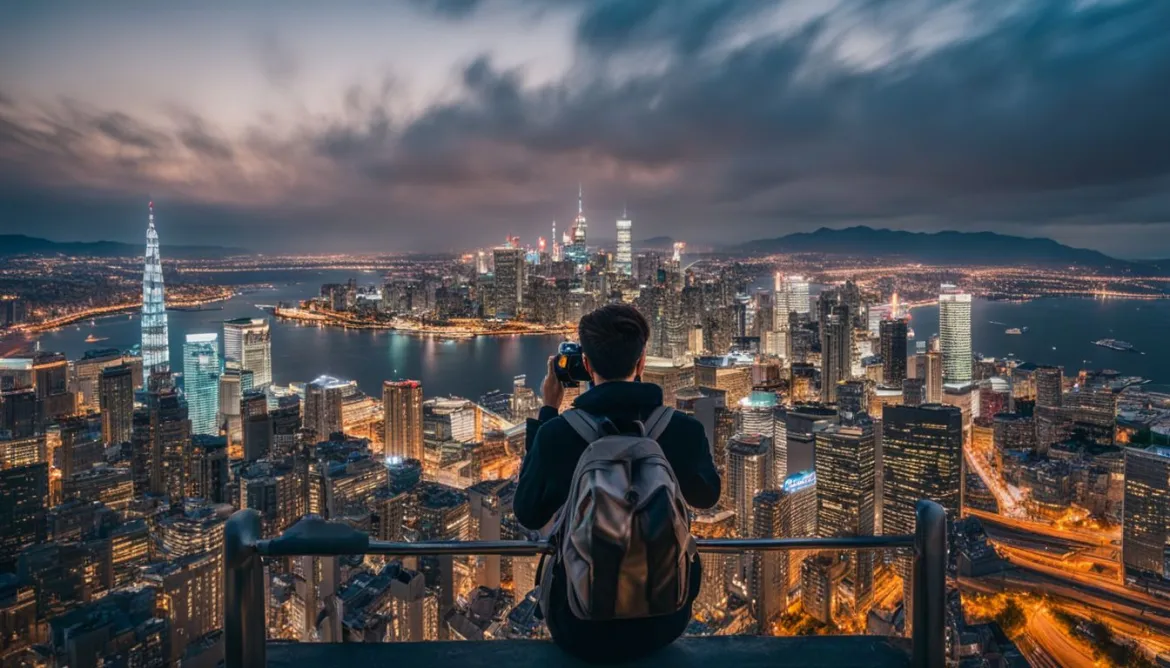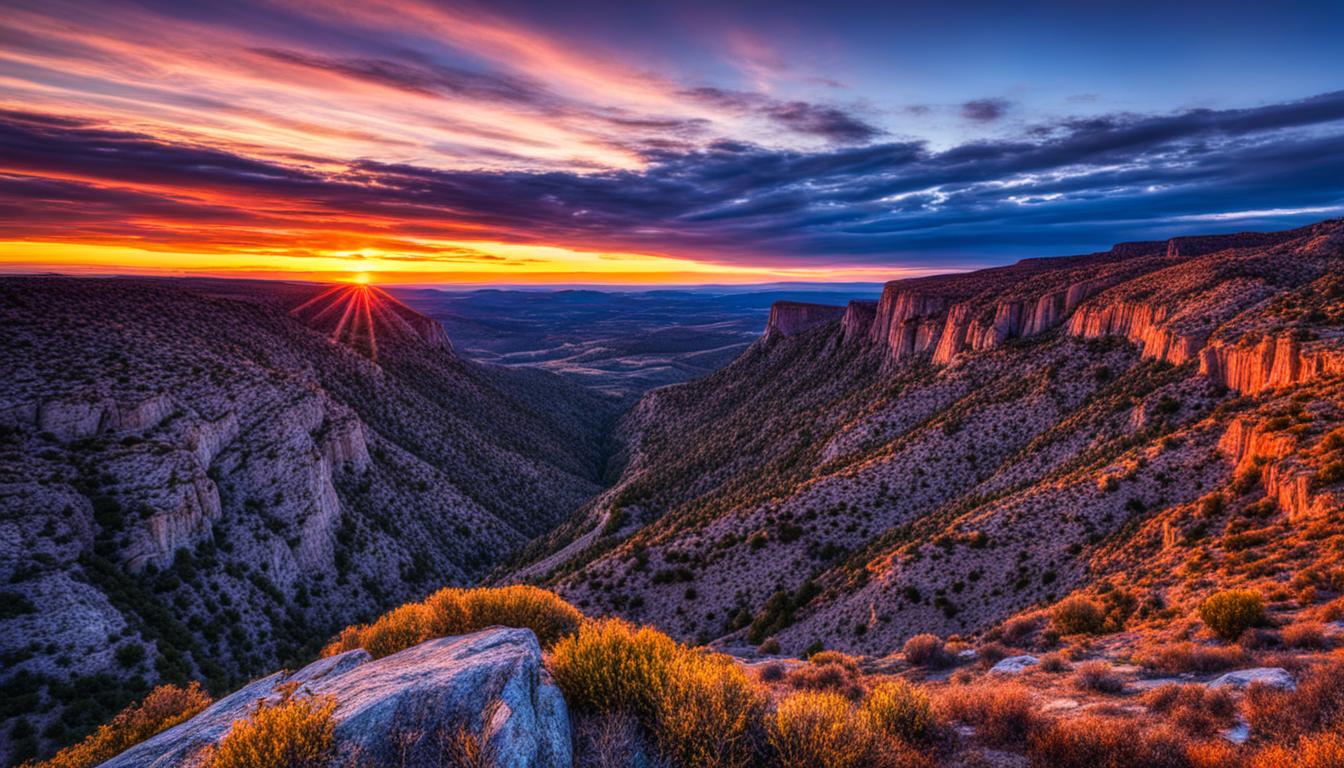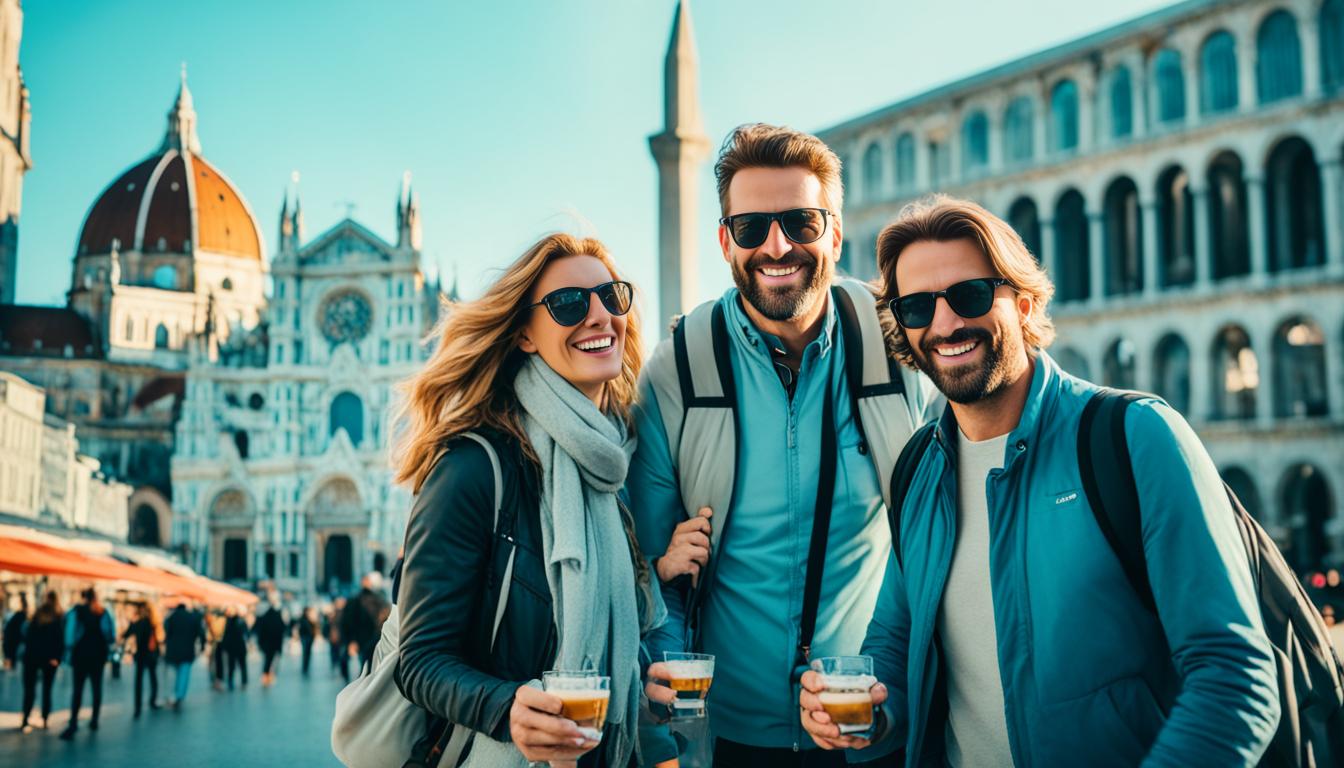Welcome to our guide on capturing breathtaking landscapes! Whether you’re a beginner or a seasoned photographer, we have the tips and techniques to help you create stunning landscape shots. From selecting the right equipment to mastering composition and lighting, we’ll cover everything you need to know to take your landscape photography to the next level.
Key Takeaways:
- Invest in the right camera and lenses for landscape photography.
- Master the use of manual camera settings to control the exposure variables.
- Understand different lighting conditions and plan your shoots accordingly.
- Utilize composition techniques such as foreground interest and leading lines.
- Research and plan your locations to make the most of your landscape photography.
Recommended Equipment for Landscape Photography
When it comes to landscape photography, having the right gear is essential to capture breathtaking images. Investing in high-quality equipment can make a significant difference in the outcome of your photographs. Here are some recommended pieces of gear for landscape photography:
1. Landscape Photography Camera
A good camera is the backbone of landscape photography. Opt for a full-frame DSLR or mirrorless camera to ensure excellent image quality, dynamic range, and low-light performance. With a high-resolution sensor, you’ll be able to capture every detail of the stunning landscapes you encounter.
2. Wide-angle Lens
Wide-angle lenses are the go-to choice for capturing expansive scenes and showcasing the grandeur of landscapes. Look for a lens with a focal length between 16mm and 24mm to capture the vastness and depth of your surroundings. This lens can help you include more of the landscape in a single frame.
3. Tripod
A sturdy tripod is essential for landscape photography, especially when shooting long exposures or capturing sharp images in low light. Look for a tripod that is lightweight, compact, and easy to carry. Make sure it has a stable base and can withstand challenging outdoor conditions.
4. Filters
Filters are valuable tools for enhancing your landscape photographs. Circular polarizers reduce glare, saturate colors, and improve contrast, while neutral density (ND) filters help control the amount of light entering the camera, allowing for longer exposures and capturing motion in water or clouds. Consider investing in a graduated ND filter to balance the exposure between the sky and foreground.
5. Accessories
In addition to the camera and lenses, there are several accessories that can enhance your landscape photography experience. Consider investing in a sturdy backpack to carry your gear comfortably during outdoor adventures. Extra batteries are crucial for extended shooting sessions, and external hard drives can help you store and back up your images while on the go.
Here is an example of a complete table showcasing the recommended equipment for landscape photography:
| Equipment | Description |
|---|---|
| Landscape Photography Camera | A full-frame DSLR or mirrorless camera for excellent image quality and dynamic range. |
| Wide-angle Lens | A lens with a focal length between 16mm and 24mm to capture expansive scenes. |
| Tripod | A sturdy tripod for stability during long exposures and low-light conditions. |
| Filters | Circular polarizers and neutral density filters to enhance colors and control light. |
| Accessories | A backpack, extra batteries, and external hard drives for convenience and storage. |
By investing in the right equipment, you’ll be well-prepared to capture stunning landscapes and create memorable photographs that truly mesmerize viewers.
Camera Settings for Landscape Photography
When it comes to landscape photography, getting the right camera settings is essential to capture breathtaking shots. By shooting in Manual mode, we have full control over the exposure variables – aperture, shutter speed, and ISO. This allows us to adjust the settings according to the specific lighting conditions and desired visual effects.
In order to maintain a deep depth of field and keep the entire scene in focus, it’s recommended to use a narrow aperture, such as f/11 or f/16. This ensures that both the foreground and background elements are sharp and well-defined. Pairing a narrow aperture with a slow shutter speed allows for more light to enter the camera, compensating for the decreased light caused by the small aperture.
Furthermore, keeping the ISO value low helps to avoid introducing noise into the images, resulting in cleaner and more detailed photos. By finding the right balance between aperture, shutter speed, and ISO, we can capture the beauty of the landscape in all its glory.
As Ansel Adams once said, “A good photograph is knowing where to stand.” But we believe it’s also about knowing how to adjust our settings to create stunning landscape images that truly captivate the viewer.
“A good photograph is knowing where to stand.” – Ansel Adams
Let’s take a look at an example of the camera settings used in a landscape photo:
| Setting | Value |
|---|---|
| Aperture | f/11 |
| Shutter Speed | 1/30 sec |
| ISO | 100 |
With these settings, we can achieve a deep depth of field, allowing both the foreground and background details to be sharp, while maintaining optimal exposure and minimizing noise.
By understanding and utilizing the right camera settings for landscape photography, we can unleash our creativity and showcase the beauty of nature through our lens.
Tips for Working with Light in Landscapes
Light is a crucial element in landscape photography. It has the power to transform an ordinary scene into something truly extraordinary. By understanding how to work with light, you can capture stunning photographs that showcase the beauty of landscapes.
When it comes to lighting, one of the best times to shoot landscapes is during the Golden Hours. This refers to the hour after sunrise and the hour before sunset when the light is soft, warm, and provides a beautiful glow. During these times, the sun is lower in the sky, creating long shadows and adding depth to your photos. The warm tones also add a touch of magic and enhance the overall atmosphere of the image.

Clouds can also play a significant role in landscape photography. They add drama and texture to the scene, transforming a plain sky into a visually dynamic canvas. On the other hand, clear blue skies can sometimes appear dull in photographs. So, don’t be afraid to wait for some clouds to roll in or incorporate them strategically into your composition.
Another exciting aspect of light in landscapes is night photography. The darkness of the night sky provides a magical backdrop for capturing starry skies and cityscapes illuminated with captivating city lights. Night photography allows you to experiment with long exposures, creating captivating streaks of light or capturing the mysterious beauty of the night.
To make the most of these lighting conditions, it’s important to plan and prepare. Research the best times to shoot for golden hour or night photography in your desired location. Scout the area in advance to find the best vantage points and take note of any potential obstacles or elements that could influence the lighting.
Remember, working with light in landscape photography is all about understanding how it affects the scene and using it to enhance the overall impact of your images. So go out, explore different lighting conditions, and let the light guide you in creating stunning landscape photographs.
Composition Techniques for Captivating Landscapes
Composition is a critical aspect of creating captivating landscape photos. It involves arranging elements within the frame to create visually appealing and engaging compositions. By using various techniques and tools, you can enhance the impact of your landscape images.
One effective composition technique is including foreground interest in your shots. Adding elements such as trees, rocks, or flowers in the foreground adds depth to the image and leads the viewer’s eye through the scene. It creates a sense of scale and dimension, making the photograph more immersive.
Leading lines are another powerful composition technique for landscapes. Utilizing elements such as paths, rivers, or fences that lead into the frame draws the viewer’s attention to a specific focal point. These lines create a visual path that guides the eye and adds a sense of perspective and direction.
The rule of thirds is a widely used composition guideline that can greatly enhance the visual impact of your landscape photos. By dividing the frame into a 3×3 grid, you can position key elements and points of interest at the intersection points. This creates a sense of balance and harmony, making the composition more compelling.
Rule of Thirds Grid:
Experimenting with different angles and perspectives can also result in unique and engaging compositions. Don’t be afraid to get low to the ground or hike to higher vantage points to achieve a fresh and captivating view. Changing the angle can alter the dynamics of the scene and bring out new aspects that may have otherwise gone unnoticed.
Remember, composition is a creative process, and there are no hard and fast rules. It’s important to explore and experiment with different techniques to find your unique style. The goal is to create visually stunning images that captivate the viewer and tell a compelling story.
By implementing these composition techniques, you can take your landscape photography to the next level, creating captivating images that stand out. Now, let’s move on to the next section and explore the essential aspects of planning and researching locations for your landscape photography adventures.
Planning and Researching Locations
Planning and researching locations is crucial to ensure successful landscape photography. By investing time in thorough preparation, you can maximize your chances of capturing stunning and unique images.
One of the first steps in location planning is conducting online research. Utilize online maps and topographical information to identify potential spots for photography. These resources can help you understand the terrain, identify interesting features, and evaluate different vantage points.
Additionally, consider the best time to visit a location. Lighting conditions play a significant role in landscape photography, so researching the times when the sun casts the most favorable light can greatly enhance your results. Sunrise and sunset are widely regarded as the Golden Hours, offering beautiful colors and soft, diffused light.
To further refine your locations, it’s beneficial to visit them beforehand and scout potential spots. This allows you to familiarize yourself with the landscape, identify potential compositions, and plan your shooting angles. By physically exploring the location, you can gain valuable insights and prepare yourself for the photography session.

Benefits of Planning and Researching Locations:
- Identify potential spots using online maps and topographical information.
- Evaluate different vantage points for compelling compositions.
- Consider optimal lighting conditions for the best results.
- Visit locations beforehand to familiarize yourself with the landscape.
- Scout potential spots to plan your shooting angles.
Taking the time to plan and research locations not only enhances the quality of your landscape photos but also enables you to make the most of your photography outings. With a well-planned approach, you’ll be better equipped to capture breathtaking images that truly showcase the beauty of the natural world.
Going Beyond the Obvious in Landscape Photography
When it comes to landscape photography, it’s important to break free from the conventional and explore creative approaches that go beyond the obvious. By experimenting with different techniques, styles, and angles, you can create truly unique and compelling images that capture the essence of the natural world.
One way to add interest and depth to your landscape shots is by including people or wildlife. By incorporating human or animal subjects, you not only add a sense of scale but also tell a story within the frame. A lone hiker on a vast mountain peak or a flock of birds soaring above a serene lake can create a captivating narrative that engages viewers on a deeper level.
Embracing the unexpected is another key aspect of pushing the boundaries in landscape photography. Instead of sticking to popular tourist spots, venture out to lesser-known locations that offer hidden gems waiting to be discovered. These hidden gems often provide unique perspectives and breathtaking landscapes that haven’t been overly photographed, allowing you to capture truly one-of-a-kind images that stand out from the crowd.
“Photography is an art, and every artist has a unique vision. Don’t be afraid to unleash your creativity and showcase the world through your own lens.”
Experimentation is fundamental to expanding your creative horizons in landscape photography. Try out different techniques like long exposures to capture the ethereal movement of clouds or water, or explore unconventional styles such as black and white to evoke a sense of timelessness. Playing with angles and perspectives can also result in visually striking compositions, unearthing fresh viewpoints that inspire awe and admiration.
Remember, landscape photography is about more than just documenting a beautiful scene. It’s an opportunity to express your individuality and create art that resonates with others. By breaking away from the obvious and embracing your own unique vision, you can capture landscapes in ways that captivate and inspire viewers.
Tips for Going Beyond the Obvious:
- Experiment with different techniques, styles, and angles.
- Add people or wildlife to your shots to create scale and storytelling.
- Venture to lesser-known locations for hidden gems and breathtaking landscapes.
- Try out unconventional techniques like long exposures or black and white photography.
- Play with angles and perspectives to capture unique and visually striking compositions.
| Techniques | Results |
|---|---|
| Long Exposures | Creates a dreamy and ethereal effect by capturing movement in clouds or water. |
| Black and White Photography | Elicits a sense of timelessness and emphasizes the texture and contrast of the landscape. |
| Unconventional Angles | Offers fresh perspectives and unique compositions that stand out from traditional landscape shots. |
So don’t be afraid to break free from the norm and explore the limitless possibilities of landscape photography. Let your creativity soar as you capture the beauty of the natural world in ways that go beyond the obvious.
Conclusion
Mastering the art of capturing breathtaking landscapes is within reach for any aspiring photographer. By combining technical skill, artistic vision, and the right equipment, you can elevate your landscape photography to new heights. Throughout this article, we have provided valuable insights and tips to help you on your journey.
Remember, investing in recommended equipment, such as a high-quality camera and wide-angle lenses, is crucial for capturing the grandeur of scenic landscapes. Understanding the importance of camera settings, such as using a narrow aperture for maximum depth of field, will ensure that every detail is in focus.
Working with light is key in creating captivating landscape photos. The soft, warm light during the Golden Hours adds a magical touch, while shooting at night opens up unique opportunities. Additionally, mastering composition techniques, such as including foreground interest and utilizing leading lines, will add depth and engage the viewer.
Planning and researching locations, as well as embracing creativity and thinking beyond the obvious, will further enhance your landscape photography. By exploring new places, seeking out hidden gems, and letting your imagination run wild, you can capture the true beauty of the natural world.
In conclusion, armed with the knowledge and techniques shared in this article, you have the power to transform ordinary landscapes into extraordinary works of art. So grab your camera, step into nature, and unleash your creativity as you embark on your journey to capture stunning landscapes.
FAQ
What gear do I need for landscape photography?
A good landscape photography camera (such as a full-frame DSLR or mirrorless model), wide-angle lenses, tripods, filters, and additional accessories like backpacks and batteries are recommended.
What camera settings should I use for landscape photography?
Shooting in Manual mode and using a narrow aperture (such as f/11 or f/16) to maximize depth of field, paired with a slow shutter speed, and keeping the ISO low to avoid noise are ideal settings.
How can I work with light in landscapes?
Shooting during the Golden Hours (around sunrise and sunset) provides soft, warm light, and understanding different lighting conditions and planning accordingly can lead to stunning photos.
What composition techniques can I use for landscape photography?
Include foreground interest, use leading lines, and experiment with angles and perspectives. The rule of thirds is a commonly used technique that divides the frame into a 3×3 grid.
How should I plan and research locations for landscape photography?
Research online maps and topographical information, consider the best time to visit a location, and visit and scout potential spots beforehand for the best compositions.
How can I go beyond the obvious in landscape photography?
Experiment with different techniques, styles, and angles. Add people or wildlife to create a sense of scale and storytelling, and explore lesser-known locations for unique and breathtaking shots.
What tips and techniques can enhance my landscape photography?
Investing in the right gear, understanding camera settings and light, employing composition techniques, and planning and researching locations can all improve the quality of your landscape photos.
What are some recommended techniques for capturing landscapes?
Using a wide-angle lens, shooting during the Golden Hours, experimenting with different angles and perspectives, and incorporating foreground interest can all result in stunning landscape shots.
How can I create captivating landscape compositions?
Include foreground interest, use leading lines, experiment with the rule of thirds, and try different angles and perspectives to create engaging compositions.
What benefits does shooting during the Golden Hours offer?
Shooting during the Golden Hours, around sunrise and sunset, provides soft, warm light and adds atmosphere and beauty to landscape photos.
Can the Essential Gear for Sports Photography also be used for Capturing Landscapes?
Yes, essential sports photography gear can also be used for capturing landscapes. Lenses with wide aperture allow for great depth of field, while a high-speed telephoto lens can capture distant landscapes. A sturdy tripod is essential for both sports photography and capturing landscapes in low light conditions.




